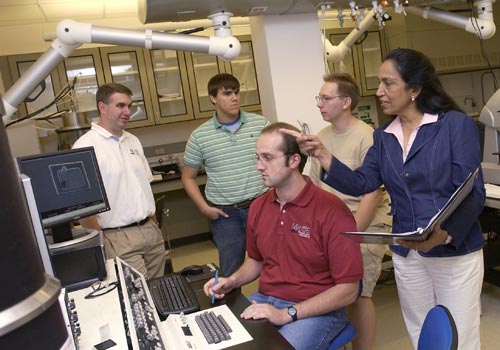Technology partnership will have profound effect on semiconductor industry
A. Sue Weisler | photographer
Professors Sean Rommel, left, and Santosh Kurinec, far right, discuss the Amberwave project with their student research team.
RIT and AmberWave Systems, a leader in the research, development and licensing of advanced technologies for semiconductor manufacturing, are collaborating on new research that has the potential to revolutionize the semiconductor industry. The partnership seeks to integrate compound semiconductor devices on silicon using an innovative technique called Aspect Ratio Trapping, also known as ART, an initial development by AmberWave, which is based in Salem, N.H.
The research is being funded through a three-year grant from the National Science Foundation. ART is a technology that may open the door to faster, more powerful chips, which could find their way into a wide range of applications from silicon-based photonics to improved photovoltaic cells. In the case of silicon photonics, ART could allow manufacturers to combine different materials onto a silicon base, forming chips that use light pulses to carry data, similar to fiber optic technology. The result is increased speed of data transmission which would be much faster than today’s current systems allow. “This award plays on the value of industry and university collaboration and the demonstrated strengths of AmberWave in the area of epitaxial thin film electronic materials,” says Donald Boyd, RIT’s vice president for research.
The semiconductor materials being investigated under this project have been used for years in niche markets, requiring extreme high-speed performance, optical properties, and/or radio frequency properties. However, they have seen little market penetration for more mainstream applications due to high costs and difficulty in integration with conventional, inexpensive silicon electronics. However, ART would allow manufacturers to capitalize on their investments in current manufacturing technologies, reducing costs considerably and allowing the devices to be included in products at consumer-friendly prices. “This research has the potential to seamlessly integrate III-V and silicon microelectronics to retain the best properties of each, opening up the possibility for truly massive speed improvements in memory and processor chips, integrated silicon-photonic devices for ultra-high bandwidth fiber-optic communications, and novel radio frequency chips for wireless communications,” Boyd adds.
The project includes Santosh Kurinec, Sean Rommel and Karl Hirschman of RIT’s Department of Microelectronic Engineering and student researchers, including Stuart Sieg, Raymond Krom and David Pawlik. IBM, following collaborative research in strain silicon technology conducted by Kurinec, first introduced AmberWave Systems to RIT’s semiconductor development efforts in 2003. Since then, AmberWave and RIT have worked closely on several projects and the company also provides highly valuable strained silicon wafers for use in several student research projects.










